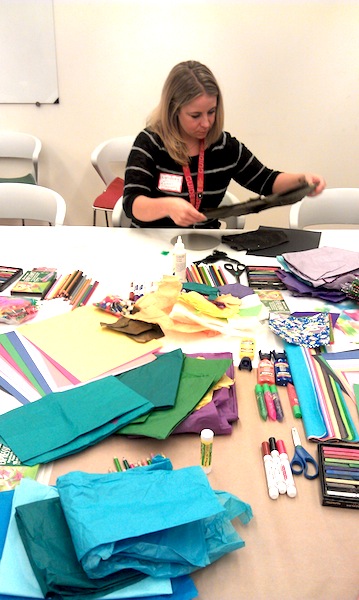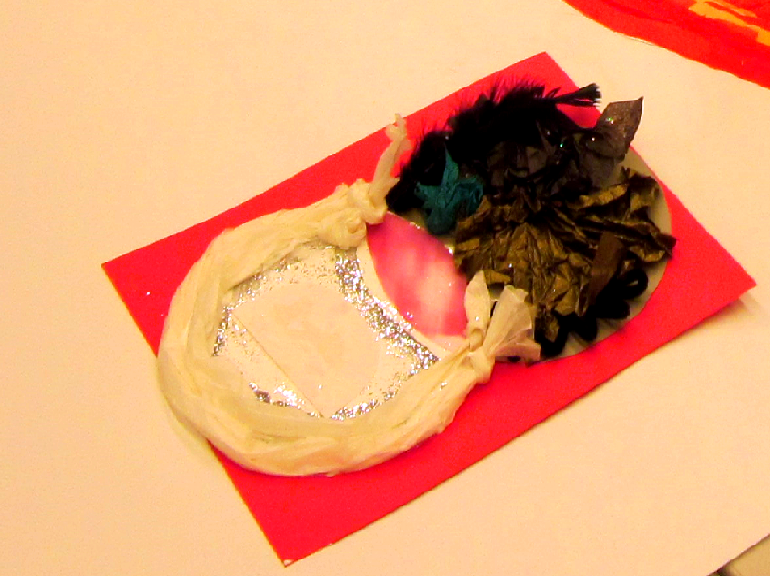Laura Sloan and Lyndsey Anderson and I welcomed a group of New York University Graduate Art Therapy students to the museum on a Saturday afternoon in late August for a workshop exploring mandalas from psycho-spiritual and experiential perspectives. The workshop objective was to help the incoming students build a sense of community and camaraderie with each other and to explore the mandala as a tool for personal insight and healing.
Christine Austin, who is a second year NYU Graduate Art Therapy student, participated in the program last year. Christine was eager to help to coordinate the program this year by serving as mentor for the younger students. She was joined by Joe Kavitski, also a second-year student.
 The program began with a tour exploring Tibetan Buddhist sacred art, in particular, the story of the Buddha’s life and the development of the role of the Boddhisattva, progressing to the rise of the mandala as a tool for integrating opposition within the psyche for Tibetan Buddhist practitioners.
The program began with a tour exploring Tibetan Buddhist sacred art, in particular, the story of the Buddha’s life and the development of the role of the Boddhisattva, progressing to the rise of the mandala as a tool for integrating opposition within the psyche for Tibetan Buddhist practitioners.
 We then moved to the Education Center and made works of art that help to express and explore feelings of conflict and opposition within our own lives. Christine had brought a rich assortment of art supplies. As we made art together, a hush fell over the room.
We then moved to the Education Center and made works of art that help to express and explore feelings of conflict and opposition within our own lives. Christine had brought a rich assortment of art supplies. As we made art together, a hush fell over the room.
These are some of Laura Sloan’s reflections:
 Building a Mandala can be an arduous process. It not only entails detailed knowledge of Buddhist doctrinal belief, it also involves a steady hand and a keen eye for geometric measurements. In the same way, incoming university students face the difficult challenge of entering unfamiliar academic and geographic territory and must tread carefully while constructing their future path. They must mentally prepare themselves for the journey ahead.
Building a Mandala can be an arduous process. It not only entails detailed knowledge of Buddhist doctrinal belief, it also involves a steady hand and a keen eye for geometric measurements. In the same way, incoming university students face the difficult challenge of entering unfamiliar academic and geographic territory and must tread carefully while constructing their future path. They must mentally prepare themselves for the journey ahead.
During our time together in the Rubin Museum Mandala Workshop, we not only shared our past experiences but also the students’ hopes for the future in their Art Therapy program. Using the Rubin Museum collection as a backdrop, our goal was to welcome them to New York City and the NYU program, while at the same time, show them how this art collection can be used as a tool for personal healing and wellness.
The program began with an hour-long tour in the galleries and culminated in collaborative art making in which each participant contributed their individual artwork to a larger Mandala. Together the students discussed their thought process with the group and shared how this experience has influenced their path forward in the program.
Just as the Mandala can be used as a tool for meditation, we hope that the NYU Art Therapy students will see the Rubin Museum not only as a personal resource but as a tool for future practice.
Lyndsey Anderson contributed the following insights:
I had the pleasure of participating in the mandala-making workshop co-organized by Laura Lombard and Laura Sloan from the Rubin Museum of Art and Christine Austin and Joe Kavitski from the NYU Graduate Art Therapy program. The experience began in the galleries and moved to the Education Center where we used the art on display for creative and emotional fodder to design and decorate our own mandalas, inspired by Tibetan Buddhist mandalas, blueprints for transformation with each deity in the center of the mandala representing the goal of transformation within oneself.
To begin, Laura Lombard led a compelling tour through one of the museum’s permanent exhibitions, Gateway to Himalayan Art, which introduces visitors to concepts of Himalayan art and culture. She encouraged us to consider dualities that exist between geographic landscapes of the Himalayan region, cultures of East and West, and within our own minds. We discussed the ways in which making, viewing, and meditating upon art can encourage transformation and healing for the participant which translated into our mandala-making activity.
Situated with a glue stick, some graphite, and a tin of glitter, I considered what we had talked about earlier in the day. Joe prompted us to reflect on the places within ourselves where our dualities overlapped. Where do the negative and positive energies meet, and become one? I meditated on my own life and concluded that I have an ever constant need to push myself, further, faster, beyond my bounds. For me, this is been the cause for the greatest things in my life, and also my most difficult challenges. Unconsciously, I tried to let myself depict this through various materials in mandala form.
To start, I felt my body tense up when I considered the negative aspects of this energy. I crumbled black paper into peaks and crevasses, bent pipe cleaners into harsh edges and aggressively placed feathers extending them beyond the smooth edge of the template. Next, I considered the positive aspects of this energy. I chose light materials, in weight and color, and delicately placed and molded the light tissue paper in rings, tied softly at the ends like a package expectant of being opened. Glitter fell, haphazardly on the page, and I left it where it landed. In the center: a pink textured shape, a space where both energies became one.
This exercise allowed me to express how I felt through art, rather than words, an exercise I have yet to examine in my own path towards healing. My working goal is to align my energies into that pink, open space that remains in the center.
In closing, working with the NYU students not only provided a wonderful opportunity for Laura, Lyndsey and I to analyze the symbolism of mandalas within a Tibetan Buddhist context; it also provided a time for us to share, create, and reflect on what these ancient and compelling symbols mean to us.




